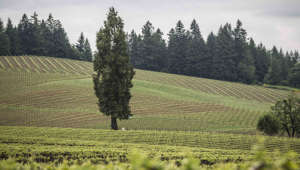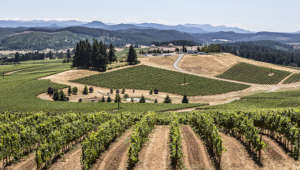Ask any self-respecting enophile to name the elements that comprise terroir, and they’re likely to say soil for sure. Climate, probably. But terrain? Not so much.
Terrain is the third of four dimensions of terroir that we are exploring in this blog, and in some ways is the most challenging to dissect. There is simply less written on the effect of terrain on grapes than the effect of soil and climate. (The fourth dimension is tradition, or the human factor. We’re saving that for last.) Before diving into a discussion of terrain, let’s recap terroir – what it means and how it influences the wine in your glass.
Terroir is often defined as “sense of place.” The French first used the word to describe the total natural environment of the vineyard. A vineyard’s terroir is unique to it and is greater than the sum of its parts: soil, sun, slope, rain, wind, temperature, elevation. Add in the human element – the choices made by the vineyard team and the winemakers – and we begin to see why terroir, and wine, is so endlessly fascinating.

No bright line exists between soil, climate and terrain. Soils vary as the terrain changes, and the terrain of a site influences the climate. Terrain is often the forgotten factor, observes Raymond Nuclo, King Estate Director of Viticulture and Winery Operations. “I don’t think people really think about terrain at all, but it plays a role,” he says. “All aspects of terroir are interconnected.”
It would be a mistake to think of terrain as only the land’s natural contours and geological features such as ridges and valleys. Terrain encompasses altitude, elevation (how steeply the land rises), orientation, proximity to bodies of water or mountain ranges, even wildlife.
King Estate’s terrain is notable in two ways – its elevation and diversity.
Wine writer Kristin Crane with Upserve, a restaurant technology company, says that altitude is being recognized more and more for the important role it plays in wine. At one time a vineyard such as King Estate, with elevations ranging from 700 to just over 1,100 feet, was considered at the upper edge of viability for a vineyard. Now regions as high as 4,000 feet, in Argentina for example, are producing great wine.
Oregon is already well suited for cool-climate grapes. At King Estate’s elevation the air is even cooler which simply exaggerates its influence. The intense summer heat we experience during the day cools more rapidly at night at higher elevations, allowing grapes to pack in the flavor without losing too much acid. Altitude gets some credit for making our wines more intriguing and complex.
In part due to the size of our estate, at 1,033 acres, we represent all kinds of terrains: steep slopes and flat spots, slopes facing all directions, at varying elevations. And not all slopes are created equal. Concave hillsides hold heat better – the oven effect. Convex slopes tend to shed heat and cool more quickly. What’s a viticulturist to do?

Ray pays special attention to aspect, or the direction the slopes face. “Slopes create their own microclimate,” he explains. For example, a north-facing slope is cooler than a south-facing one. Part of his job is to match the clone to the slope. Earlier ripening clones or grapes for sparkling wine or rosé, which require lower sugar levels, are best for a northerly slope, for example.
While slopes might typically be avoided in other forms of agriculture, slopes are a grape grower’s friend. Slopes provide frost protection, because cold air drains downhill. Soil is thinner and thus less fertile on slopes, which helps control vegetation growth. (The more the grapevine is throwing off shoots and leaves, the less energy it has to fully develop the berries.)
Even as we examine the facets of terroir – how soil, climate and terrain all work together – it is increasingly clear that the human factor plays a crucial, defining role in shaping the wine we enjoy in our glass. In our next blog, we’ll take a closer look at the winemaker’s hand.
